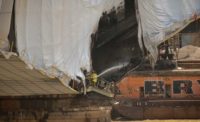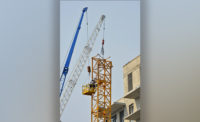I
t’s not every day that a project interior designer sits down with the project team to discuss construction and occupant safety. But in 2019, Keith Switzer, who heads interior design firm INTEC Group, found himself in meetings doing just that as plans took shape for a four-story office and research building in the Boston suburb of Billerica. The project’s owner, drug maker EMD Serono, was “very keen” on safety, Switzer recalls. So leaders from the project’s prime contractor, Erland Construction, and much of the project team gathered regularly in an existing building at the project site, and later sometimes in a project trailer, where the vibe was for a “roll up your sleeves effort … literally everyone at the table throwing out ideas.” Even after the pandemic shifted the meetings to the internet, the basic mission as Switzer sees it was to explore ideas where “if you did this differently, this would be a safer way of doing XYZ.”
![]()
The result has been a project, more than halfway to completion, with no serious injuries so far and a list that can grow to include still more possible safety-related changes. That list essentially is a long-running diary of every idea for protecting the building’s construction workers and future maintenance staff and occupants. The 122 changes made so far amount to dozens of avoided trips and slips, gnarled knees and fingers, of tragedies erased from the calendar of future human mishap.
One entry calls for a lift to support ironworkers making all moment welding connections on the building’s steel frame (No. 51). Another calls for anchors for safety tie-offs for window washing (No. 58). Of special import was entry No. 1: “Move the building” away from an existing building, avoiding need for extensive shoring and retention systems.
EMD Serono has long used the safety hazard identification and mitigation process known as Prevention through Design, or PtD, says Tony Meenaghan, the firm’s senior director of environmental health and safety-related facilities management and engineering. EMD Serono’s project team—led by Erland, a Burlington, Mass.-based construction manager, and architect PM Group—have run with it. “It’s really simple, but it takes commitment and discipline,” says Meenaghan.
By revealing the details of the New Heights project in Billerica, EMD Serono and Erland may invite fresh interest in the approach. It has been championed by some risk professionals, consultants and engineering faculty since the early 1990s. The federal government’s National Institute for Occuptional Safety and Health began promoting it in 2007—NIOSH has even issued an instruction manual for how to teach PtD to architects. But over the decades other safety approaches, such as behavior-based safety programs or use of predictive analytics to focus attention on danger spots, seemed to have gained more attention.
Prevention through Design’s central focus is an exhaustive process of identifying and eliminating hazards, used in conjunction with typical safety training and personal protective equipment. The method’s advocates ask why workers should ever need to be put in a position to navigate hazards or make difficult decisions about risk avoidance in the field. A hazard identified, they say, is a hazard that can be mitigated partly or completely.
When Erland prepared its bid based on schematic designs and won the contract to build the roughly $60-million project, the contractor had performed numerous projects for EMD Serono, but not using PtD. Although this project is being performed using a traditional design-bid-build delivery, and while Erland doesn’t “own” the design, the firm is working closely with the owners representative and the project architect, PM Group, on the safety PtD effort.
A longtime hindrance to design-phase hazard analysis has been the decades-old legal wisdom by which architects and engineers, in order to escape potential liability for accidents, sign contracts explicitly stating that they do not participate in means and methods of construction and that their professional services pertain only to design and the plans they seal or stamp. Constructability reviews and design-assist project delivery raise similar issues to PtD, although they aren’t as directly safety related.
The old legal wisdom has adjusted to changing times, though. Sitting at a conference table making suggestions about safety isn’t the same as performing formal design services, insurers say, and other processes that blur traditional roles, such as design-build, haven’t led to huge numbers of lawsuits. Design-build by its nature facilitates hazard identification and mitigation in the design phase.

With safety typically resting on the shoulders of the construction contractor and project manager, Matthew Combs, Erland’s project manager, says he found it “refreshing” to have the project’s architects and engineers involved as well. And Philip Koeniger, architectural department manager for PM Group, notes that EMD Serono’s building is his firm’s first PtD project, and yet there was no need for any special insurance coverage or contract terms. “These are all implemented to make the building more secure and more safe, not only for the people working there, but for the contractors as well,” he said.
In any case, his company was not increasing its exposure to lawsuits and was still protected by the traditional legal distinction between designers performing design and construction. “We are not dictating means and methods, we are providing a design,” Koeniger said.
Other trends now also invite design-phase safety review.
Richard Hislop, a safety consultant, says building information modeling and potential savings from using BIM are steering more safety discussions into design phases. “By putting the design in three dimensions to detect conflicts, I think there are those that recognize value and incorporate safety people from construction and operational points of view, and feel that eliminating hazards in the design phase can avoid changes and costs.”
Sustainability and climate change have had an influence, too. The U.S. Green Building Council provided a boost to Prevention through Design in 2015 when it agreed to make accident prevention—the sustaining of human health and life—eligible for credit under the council’s popular LEED accreditation system. The credit, created in collaboration with NIOSH, is gaining traction. NIOSH’s statistics show 205 projects qualified for the LEED credit in 2018, the latest year for which there is information.
Owners have driven improvements in construction in the past and the same appears to be happening with PtD. Companies such as Intel, Exxon and Southern Co. all have used or expressed interest in the process, said John Gambatese, a safety expert and professor of civil engineering at Oregon State University.

No special project legal terms were drawn up for the EMD Serono project. The drug maker, PM Group and Erland developed a job-specific safety program that included a safety charter and a flyer about Prevention through Design, and both were incorporated in all subcontractor bid packages, says Combs, “so subcontractors were aware of the project safety standards.”
Kicking things off, EMD Serono held a mandatory “safety day” before construction launched in mid-2019. Erland’s project team had come up with a lofty goal of identifying 150 potential design changes. As the process got rolling over weeks and months, ideas begat more ideas.
Now, with construction about two-thirds complete, the Erland team is expanding its list of potential design changes, with more ideas continuing to roll in. “It’s contagious, that is what is so fun about it,” says Anette Balestrand, assistant project manager for Erland. “Once people see it and realize it’s safer and better for them, they want to join the cause.”
PM Group’s Koeniger says one major issue that came up was what to do with the loading docks, which are typically built four feet off the ground to accommodate unloading of trucks. EMD Serono disliked the idea of a raised dock, citing safety issues, as well as limited space to work with. After “a whole round of discussions” and design iterations, “we eliminated the dock” and replaced it with a recessed scissors lift, which kicks into action when unloading needs to be done. “It created a larger floor area, and a larger and safer work environment,” Koeniger said.
Implementing the Changes
How did other changes get made, such as making perimeter column splice height adjustments? The project team had to hear from second- or third-level subcontractors in some cases.

For example, the structural engineer, Lemessurier Consultants, was involved in meetings on column splices, but the actual fabricator, Ocean Steel, came up with most of the ideas, Combs says. Since Ocean Steel “owned” that aspect of the design through its work for American Steel and Precast Erectors, Ocean Steel had the most knowledge of what details would translate into the safest installation. “Hence the collaborative approach necessary to implement PtD,” Combs wrote in an email. “You need to bring in the subcontractor (people actually performing the work) as well as the engineers (people ensuring the design is not compromised) to find the most impactful items.”
What did the changes do to the project cost? It’s hard to put a number on it, Combs says, but a lot of the changes became part of the “buyout” with the subs. For example, when the project team increased the weight capacity of the elevators so lifts could be moved in them for owner maintenance later on, that cost was bought out with Kone, the elevator supplier. So EMD Serono ultimately paid for it as part of that scope in the sub award process. Some of the changes also save money, Combs reports, “so it would be difficult to put a figure to all of these.”
Prevention through Design concepts can be traced back to the 1950s, yet it wasn’t until the early 1990s that the practice acquired some momentum. Gambatese wrote his PhD dissertation on the subject, and research sponsored by the Construction Industry Institute, carried out by Gambatese and the late civil engineering professor Jimmie Hinze, showed design-phase hazard mitigation’s potential. In 1995, the National Safety Council published a position paper on the subject. More impetus came in 2005 when an insurance industry safety engineer, Fred Manuele, pointed out that designing out hazards was rarely mentioned in safety and health literature. Manuele also found that while design issues often were a cause of accidents described in reports, few reports included design in recommended corrections. NIOSH got behind Prevention through Design in 2007 and has kept up its support since then.

In 2011, the American National Standards Institute (ANSI) and the American Society of Safety Professionals (ASSP) published the ANSI/ASSE Z590.3 Prevention through Design Standard. It is now being revised. And although American Society of Civil Engineers documents on engineering practice already discuss safety in several places, committees of the association’s leadership council and construction institute are developing more guidance materials.
Nevertheless, Prevention through Design remains an uncommon practice. NIOSH director John Howard wrote in 2019 that “history shows us that it is a concept too little used.”
When he was working as a structural engineer in San Francisco before switching to academia full time, Gambatese recalls “hearing from one of my supervisors that we did not need to address safety in our designs because ‘safety was what the contractor did.’ Things change slowly.”
But the new EMD Serono project shows change is possible—and it has had no lost-time accidents since work started in April 2019, through 226,234 hours of work.








Post a comment to this article
Report Abusive Comment